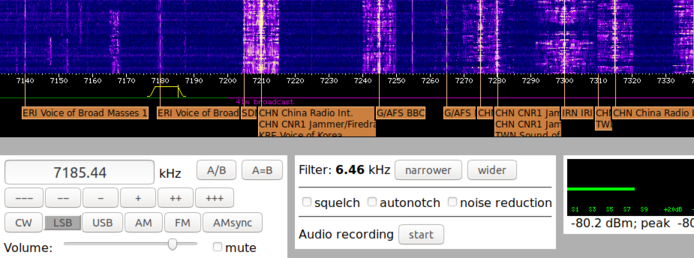Explanation and operation
What are Number Stations?
Number stations are a type of shortwave radio brodcasts. Shortwave radio transmits on lower frequencies compared to the common AM and FM broadcast types. As a result, it has a wider range of transmission and can be heard from almost any corner of the world. This enables these stations to be heard from almost anywhere.

The interface of WebSDR, a remote radio receiver.
After the Cold War, mysterious stations started to appear on the shortwave spectrum. They would either contain an encrypted morse code message, or, more interestingly, a synthesized voice saying a seemingly random string of numbers. It is safe to say that this piqued the interest of many hobbyists and so people began to wonder what they actually mean and why they're there in the first place. These hobbyists began to keep track of their schedules and give them all sorts of names in order to catalog them - "The Swedish Rhapsody", "Lincolnshire Poacher", "Drums and Trumpets", "Chinese Robot", etc.

While at first these names might seem as random as the numbers that are broadcasted, they're named after the so-called "callsign" they contain. When a station begins transmitting, it begins with what is essentially an identicator or a notifier for the recepients to know they've tuned in to the correct station. These range from folklore songs to a tone going up and down a musical scale. This would go on for a while until it begins doing what it does best - saying numbers.
As for the numbers itself, this is where it gets interesting and we'll dive into the context and the common agreement as to what they actually mean.
At their most basic, these stations transmit encrypted messages to specific recipients. A common consensus is that these are from intelligence agencies, broadcasting to field agents/spies operating in foreign countries. As the agencies broadcast using heavy transmitters to get a message across, it's impossible for field agents to respond to them, which makes it a one-way communication. In terms of the encryption of those messages, number stations provide a near impossible to crack layer of security using the so-called "one-time pads". When an agent is dispatched, the agency will provide them with a unique set of small sheets of paper which is the key to decrypting these messages. Once the message is decrypted, the format of the one-time pad is discarded for the safety of future transmissions, giving it its name (and its safety).

A one-time pad.